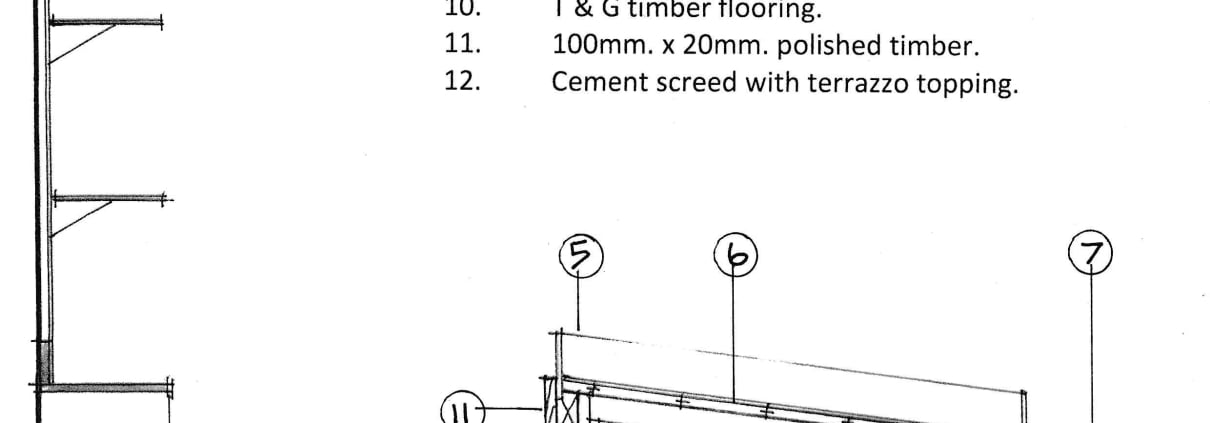Getting it Together
As we saw in the last article on early machine shops, standard practice today is also very different for the joinery shop. In both cases, this was mainly due to the introduction of materials like particle board. With their introduction many of the tools and practices that were the backbone of the joinery shop quickly became redundant.
The drawing below is of a cross-section of a standard Woolworths service counter of the 1950’s. Constructed entirely of solid timber it required the machining of the component parts before assembly and the lacquering and polishing after. These counters were often made in continuous lengths of up to15 metres. It can be seen how the labour intensity of the design would lead to the development of new, more efficient retail solutions, as labour costs started to rise.
Again, the newly available materials were to play a significant part. Before this, however, standard practice in the joinery shop would have been something like this.
Using the Woolworths counter as an example, the first thing to be done was to prepare a full-sized setout. It was usually done by personnel well versed in the manufacture and fabrication of joinery, as well as being able to visualise the completed works. The importance of this is obvious, as any mistake made here would result in the proposed item being made incorrectly, which could lead to even more unforeseen complications with expensive rectification. Setouts would be prepared, preferably on wide solid timber and plywood, but rolls of brown paper or butchers paper were also often used.
In the case of a shopfront, the setout would involve a series of timber rods indicating the width, height and depth. It was essential the rods indicate every exact detail so there could be no confusion as to what was required and ensuring all the components would be machined correctly. The proven 3–4–5 method was adopted when setting out large work requiring a right angle.
Once the setout was completed, the standard practice was to prepare a cutting list of all the component parts as a further guide to firstly the machine shop and then to the joiners. The accounts department would also use this for job costing. The success of all projects depended on the accuracy of the setout rods, for they would be the basis from start to finish, going from the machine and joinery shops to finally be the onsite instruction. By their nature, the rods minimised mistakes or errors as everyone was singing off the same song sheet.
The joiner would receive materials usually cut to size as well as the setout rod from the machine shop for the assembly and fabrication of the chosen works. As an example, we take a look here at a shopfront window back door where a timber subframe would be assembled then each sidelined with plywood using hot melt glue. Rails on the frame would either have holes bored in them, or they would have a series of trenches to allow air circulation to stop the door from bowing. The long edges would have a solid timber edging then the door would be sanded by hand ready for paint or polish finishing. By the late 1950 ’s belt and orbital power hand sanders became available. This process was of course much more expensive than a sheet of melamine board.
In the case of shopfront framing and doors, materials would come machined to required shape and joints would be partially cut in the machine shop and then the joiner would complete the joints and assemble the items before setting about to clean up with the use of hand tools such as planes, cabinet scrapers and sandpaper usually held with the assistance of a cork block.
In the early 1950’s, before PVA, many joinery shops had glue crystals, made from rendered down animal carcass in an inner pot which then sat in an outer pot containing hot water to melt the glue. In the mid 50’s came the electric thermostatically controlled glue pots. The late 1950’s saw the introduction of PVA glues. Also during this period came the first pre-glued timber veneer edging which was applied by hand and was the forerunner of today’s edge banders.
Apart from the very expensive coreboard, which was constructed from solid timber batten substrate, cross band veneer and a timber veneer face on both sides, there were no sheet boards like particleboard on the market so most items constructed would have a timber base frame lined with plywood or Masonite. Even centre divisions in counters were timber framed all having to be fabricated by the joiner. Although a lot of the materials came to the joiner cut to size for fabrication, there still was a considerable amount of work involved in the finishing of the products. This required the need for a comprehensive kit of hand tools. Tools that were in every joiners kit like various planes, chisel sets and pump action screwdrivers, were to fall into disuse, when, during the 1960s the emergence of electric power hand tools changed the way things were done and many tasks became simpler.
With the arrival of the sheet boards, including the melamine prefinished type, the design and methods of construction of joinery items changed dramatically significantly reducing the activities of the machine shop. Larger beam and sliding panel saws entered the market. These did not require a specialist wood machinist resulting in joiners cutting their own projects ready for assembly. Hardware suppliers were quick to react, and soon the market was awash with every conceivable component for the fixing of joints to cope with the new methods of construction and the market is still responding to meet today’s changing requirements.
Perhaps the most remarkable industry occurrence has been the game-changing point-to-point computerised machinery which has altered so many aspects of how items are now manufactured. Many tradespeople have progressed to become technicians who are able to programme these computer-generated machines, and the basics are also being taught in current TAFE courses. Components being produced using these machines are precise and make for easy assembly for the joiners.


Leave a Reply
Want to join the discussion?Feel free to contribute!